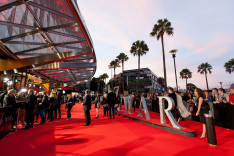Roll out the red carpet
With film premieres costing up to $350,000, who benefits from throwing these lavish events? In a feature that first appeared in Encore, Lee Zachariah investigates.
In the film world, the instant signifier of opulence and glamour is the bit of material that the stars tread on to get from their limo to the theatre. In Australia, red carpet premieres remain the preferred way of turning a film into a big event, be it an Australian production filled with starry-eyed newcomers, or a big Hollywood blockbuster featuring a bewildered, jetlagged star midway through their layover. It looks like a lot of fun for the people who go, but the question must be asked: what purpose do they serve?
“The core purpose of hosting a premiere event is generating publicity for the film,” says Universal’s Suzanne Stretton-Brown. This year, Universal has brought Steve Carell to Australia for the premiere of Despicable Me 2 and will next week host Simon Pegg, Nick Frost and Edgar Wright for the Australian premiere of The World’s End. “It’s about the celebration of a film release, particularly when the star has travelled from the other side of the globe to visit Australia. It also presents an important opportunity to showcase the film to tastemakers and business partners in the best possible setting,” says Stretton-Brown.
Although a film such as The World’s End is relatively low-key by Hollywood standards (not least of all because it was made in the UK), its internationally-recognised stars make it significantly bigger than most of its Australian counterparts like producer Rosemary Blight who saw great success with the 2012 film The Sapphires.


We have less screens to show movies that other countries so having an Australian red carpet premiere does not really make an impact overall and most stars cannot make the trip down under.
The general public see red carpet events either on the news or on shows like Today with that awful Richard Wilkins. I think distributors could spend their marketing money better on targeted advertising, public events, flash mobs, viral campaigns..etc
Sony Pictures (who is quickly becoming one of the worst film distributors in Australia for all the crap that they pull) delayed the release of last year’s James Bond film, Skyfall, in Australia by a month because they wanted the stars to walk the red carpet in Sydney. They had fans begging them to release the film with the rest of the world on their Facebook page (side note, they often have people begging them to release their films at all, to which they just give a don’t care attitude) and they refused to budge. Having Daniel Craig walk a carpet in Sydney isn’t going to create a massive box office explosion for a pre-existing franchise, and such a famous one at that!
Was This Is The End really needed to be delayed a month just so Seth Rogan could come to Australia yet again? And guess who is distributing that film? Sony Pictures.
With piracy so rampant it’s baffling that film distributors are still acting like its 10 years ago and it’s fine to delay a film simply to bring a star to walk a carpet. Unbelievable!